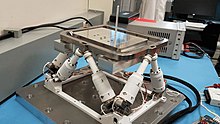Planetary Instrument for X-Ray Lithochemistry

Planetary Instrument for X-Ray Lithochemistry (zkráceně PIXL) je nástroj, který pomocí rentgenu provádí fluorescenční spektometrii.[1] Slouží k určení chemického složení povrchových materiálů na Marsu. Vznikl jako součást mise Mars 2020 a je umístěn na roveru Perseverance.[2] Zařízení PIXL vyrobila NASA Jet Propulsion Laboratory (JPL). [3]
Název
Název PIXL je dovozen od názvu obrazového bodu pixel. Poprvé slovo pixel použil Frederic C. Billingsleym z Jet Propulsion Lab, odkud pochází i zařízení PIXL.[2]
Technologie

PIXL je velice přesný spektometr - dle vědců by měl rozeznat i objekty menší než je zrnko soli (přibližně 0,12 milimetru).[4][5] Zařízení zjišťuje, zda se na Marsu někdy nacházel život. Zařízení je umístěné na hexapodu, který jej stabilizuje. PIXL detekuje dvacet chemických ukazatelů každého vzorku.
Cíle
Zařízení má 3 hlavní úkoly:
- Poskytnout informace o geochemickém složení a vývoji v průběhu času a také o případné obyvatelnosti planety.
- Detekovat všechny potencionální stopy po životě na Marsu.
- Poskytnout informace nutné k rozhodování o případném navrácení vzorků zpět na Zemi.
Technické specifikace
- Umístění: na konci robotické paže
- Hmotnost: hlavní senzory - 4,3 kilogramu; elektronika uvnitř roveru - 2,6 kg; kalibrační terč - 0,015 kg
- Napájení: 25 Wattů
- Rozměry: 21,5 x 27 x 23 centimetrů
- Vrácení dat: 16 Mb/experiment; 2 MB denně
Vývoj
Vývoj zařízení probíhal v Jet Propulsion Laboratory v Pasadeně v USA.
Galerie
- Zařízení PIXL
- Světlo ze zařízení PIXL
- Popis zařízení PIXL
Odkazy
Reference
- ↑ ALLWOOD, Abigail C.; HUROWITZ, Joel A.; CLARK, Benton C. The PIXL Instrument on the Mars 2020 Perseverance Rover. arXiv:2103.07001 [physics]. 2021-03-11. ArXiv: 2103.07001. Dostupné online [cit. 2021-04-26].
- ↑ a b MARS.NASA.GOV. Planetary Instrument for X-ray Lithochemistry (PIXL). mars.nasa.gov [online]. [cit. 2021-04-26]. Dostupné online. (anglicky)
- ↑ HTTPS://JPL.NASA.GOV. Mars 2020 Rover's PIXL to Focus X-Rays on Tiny Targets. NASA Jet Propulsion Laboratory (JPL) [online]. [cit. 2021-04-26]. Dostupné online. (anglicky)
- ↑ kosmonautix.cz [online]. 2020-09-28 [cit. 2021-04-26]. Dostupné online.
- ↑ MARS.NASA.GOV. PIXL for Scientists. mars.nasa.gov [online]. [cit. 2021-04-26]. Dostupné online. (anglicky)
Související články
Externí odkazy
 Obrázky, zvuky či videa k tématu Planetary Instrument for X-Ray Lithochemistry na Wikimedia Commons
Obrázky, zvuky či videa k tématu Planetary Instrument for X-Ray Lithochemistry na Wikimedia Commons
Média použitá na této stránce
PIA24094: PIXL's Hexapod Has Moves
PIA24094-MarsPerseveranceRover-PIXL-Hexapod-20200922
A device with six mechanical legs, the hexapod is a critical part of the Planetary Instrument for X-ray Lithochemistry (PIXL), one of the instruments aboard NASA's Perseverance Mars rover. The hexapod allows PIXL to make slow, precise movements to get closer to and point at specific parts of a rock's surface in order for the instrument to use its X-ray to discover where — and in what quantity — chemicals are distributed there. This GIF has been considerably sped up to show how the hexapod moves.
Both PIXL and Perseverance were built and are operated by NASA's Jet Propulsion Laboratory in Southern California.
For more information about the mission, go to https://mars.nasa.gov/mars2020/.PIA18406: X-Ray Instrument for Mars 2020 Rover is PIXL
http://photojournal.jpl.nasa.gov/catalog/pia18406
This diagram depicts the sensor head of the Planetary Instrument for X-RAY Lithochemistry, or PIXL, which has been selected as one of seven investigations for the payload of NASA's Mars 2020 rover mission. PIXL is an X-ray fluorescence spectrometer that will also contain an imager with high resolution to determine the fine-scale elemental composition of Martian surface materials.
Mars 2020 is a mission concept that NASA announced in late 2012 to re-use the basic engineering of Mars Science Laboratory to send a different rover to Mars, with new objectives and instruments, launching in 2020.
NASA's Jet Propulsion Laboratory, a division of the California Institute of Technology, Pasadena, manages NASA's Mars Exploration Program for the NASA Science Mission Directorate, Washington.PIA24092: Perseverance's PIXL at Work on Mars (Illustration)
https://photojournal.jpl.nasa.gov/catalog/PIA24092
In this illustration, NASA's Perseverance Mars rover uses the Planetary Instrument for X-ray Lithochemistry (PIXL). Located on the turret at the end of the rover's robotic arm, the X-ray spectrometer will help search for signs of ancient microbial life in rocks.
Both PIXL and Perseverance were built and are operated by NASA's Jet Propulsion Laboratory in Southern California.
For more information about the mission, go to https://mars.nasa.gov/mars2020/.PIA24095: PIXL's Nightlight
https://photojournal.jpl.nasa.gov/catalog/PIA24095
The Planetary Instrument for X-ray Lithochemistry (PIXL), one of seven instruments aboard NASA's Perseverance Mars rover, requires pictures of rock targets to autonomously position itself. Because PIXL works at night, it is equipped with light diodes circling its opening to take pictures of rock targets in the dark. Using artificial intelligence, PIXL relies on the images to determine how far away it is from a target to be scanned.
PIXL and Perseverance were built and are operated by NASA's Jet Propulsion Laboratory, a division of Caltech, in Southern California.
For more information about the mission, go to https://mars.nasa.gov/mars2020/.PIA24093: Perseverance's PIXL Opens its Dust Cover
https://photojournal.jpl.nasa.gov/catalog/PIA24093
The Planetary Instrument for X-ray Lithochemistry (PIXL) opens its cover during testing at NASA's Jet Propulsion Laboratory. Located on the turret at the end of the rover's robotic arm, the X-ray spectrometer is one of seven instruments aboard Perseverance and will help search for signs of ancient microbial life in rocks.
Both PIXL and Perseverance were built and are operated by JPL, a division of Caltech, in Southern California.
For more information about the mission, go to https://mars.nasa.gov/mars2020/.






